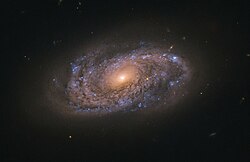NGC 2906
The topic of NGC 2906 is of utmost importance today, as it has a significant impact on various areas of daily life. From its influence on the economy to its role in society, NGC 2906 is a topic that does not go unnoticed. Throughout history, it has been the subject of debate and analysis, and its relevance remains valid today. In this article, we will explore the different facets of NGC 2906 and its importance in today's world.
| NGC 2906 | |
|---|---|
 NGC 2906 by Hubble Space Telescope | |
| Observation data (J2000 epoch) | |
| Constellation | Leo |
| Right ascension | 09h 32m 06.2s[1] |
| Declination | +08° 26′ 30″[1] |
| Redshift | 0.007138 ± 0.000020 [1] |
| Heliocentric radial velocity | 2,140 ± 6 km/s[1] |
| Distance | 126 ± 24 Mly (38.8 ± 7.2 Mpc)[1] |
| Apparent magnitude (V) | 12.5[2] |
| Characteristics | |
| Type | Scd [1] |
| Apparent size (V) | 2.1′ × 1.0′[1] |
| Other designations | |
| UGC 5081, CGCG 063-001, MCG +02-25-001, PGC 27074[1] | |
NGC 2906 is a spiral galaxy in the constellation Leo. It is circa 120 million light years from Earth, which, given its apparent dimensions, means that NGC 2906 is about 75,000 light years across. It was discovered by William Herschel on December 28, 1785.[3]
The galaxy is characterised by a normal star formation rate,[4] which has been calculated to be 0.8 M☉ per year. The total mass of the galaxy is estimated to be 4×1010 M☉.[5] A total of 241 HII regions have been identified in the galaxy.[6]
One supernova has been observed in NGC 2906, SN 2005ip. The supernova was discovered by T. Boles on November 6, 2005, with a 0.35m refractor, with an estimated apparent magnitude 15.5 and was identified as a type II supernova, probably within a few weeks past explosion.[7] As the supernova declined in brightness, it reached a plateau that lasted for a bit more than two years and its spectrum became dominated by narrow lines (IIn), an unusual feature of supernovae, that was attributed to the interaction of the supernova with dust located around it.[8] It is also possible that the supernova created dust.[9]
NGC 2906 is member of a group of galaxies, the NGC 2894 group. Other galaxies identified as members of the cluster are NGC 2882, NGC 2894, and IC 450.[10]
References
- ^ a b c d e f g h "NASA/IPAC Extragalactic Database". Results for NGC 2906. Retrieved 2016-01-18.
- ^ "Revised NGC Data for NGC 2906". spider.seds.org. Retrieved 25 November 2018.
- ^ Seligman, Courtney. "NGC 2906 (= PGC 27074)". Celestial Atlas. Retrieved 19 November 2018.
- ^ Bellocchi, E.; Ascasibar, Y.; Galbany, L.; Sánchez, S. F.; Ibarra–Medel, H.; Gavilán, M.; Díaz, Á. (17 May 2019). "Uncertainties in gas kinematics arising from stellar continuum modeling in integral field spectroscopy data: the case of NGC 2906 observed with VLT/MUSE". Astronomy & Astrophysics. 625: A83. arXiv:1903.06252. Bibcode:2019A&A...625A..83B. doi:10.1051/0004-6361/201834478.
- ^ Sánchez, S. F.; Pérez, E.; Sánchez-Blázquez, P.; García-Benito, R.; Ibarra-Mede, H. J.; González, J. J.; Rosales-Ortega, F. F.; Sánchez-Menguiano, L.; Ascasibar, Y.; Bitsakis, T.; Law, D.; Cano-Díaz, M.; López-Cobá, C.; Marino, R. A.; Gil de Paz, A.; López-Sánchez, A. R.; Barrera-Ballesteros, J.; Galbany, L.; Mast, D.; Abril-Melgarejo, V.; Roman-Lopes, A. (April 2016). "Pipe3D, a pipeline to analyze Integral Field Spectroscopy Data: II. Analysis sequence and CALIFA dataproducts". Revista Mexicana de Astronomía y Astrofísica. 52: 171–220. arXiv:1602.01830. Bibcode:2016RMxAA..52..171S.
- ^ Galbany, L.; Anderson, J. P.; Rosales-Ortega, F. F; Kuncarayakti, H.; Krühler, T.; Sánchez, S. F.; Falcón-Barroso, J.; Pérez, E.; Maureira, J. C.; Hamuy, M.; González-Gaitán, S.; Förster, F.; Moral, V. (3 December 2015). "Characterizing the environments of supernovae with MUSE". Monthly Notices of the Royal Astronomical Society. 455 (4): 4087–4099. arXiv:1511.01495. doi:10.1093/mnras/stv2620. S2CID 53648987.
- ^ "IAUC 8628: 2005io, 2005ip, 2005iq". www.cbat.eps.harvard.edu.
- ^ Smith, Nathan; Silverman, Jeffrey M.; Chornock, Ryan; Filippenko, Alexei V.; Wang, Xiaofeng; Li, Weidong; Ganeshalingam, Mohan; Foley, Ryan J.; Rex, Jacob; Steele, Thea N. (20 April 2009). "Coronal lines and dust formation in SN 2005ip: not the brightest, but the hottest type IIn supernova". The Astrophysical Journal. 695 (2): 1334–1350. arXiv:0809.5079. Bibcode:2009ApJ...695.1334S. doi:10.1088/0004-637X/695/2/1334. S2CID 15737210.
- ^ Nielsen, Ann-Sofie Bak; Hjorth, Jens; Gall, Christa (27 March 2018). "Early gray dust formation in the type IIn SN 2005ip". Astronomy & Astrophysics. 611: A67. arXiv:1801.04217. Bibcode:2018A&A...611A..67B. doi:10.1051/0004-6361/201629904.
- ^ Makarov, Dmitry; Karachentsev, Igor (21 April 2011). "Galaxy groups and clouds in the local (z~ 0.01) Universe". Monthly Notices of the Royal Astronomical Society. 412 (4): 2498–2520. arXiv:1011.6277. Bibcode:2011MNRAS.412.2498M. doi:10.1111/j.1365-2966.2010.18071.x. S2CID 119194025.
External links
 Media related to NGC 2906 at Wikimedia Commons
Media related to NGC 2906 at Wikimedia Commons- NGC 2906 on WikiSky: DSS2, SDSS, GALEX, IRAS, Hydrogen α, X-Ray, Astrophoto, Sky Map, Articles and images